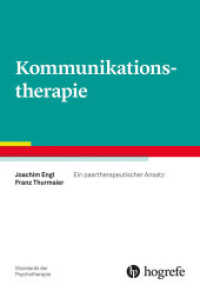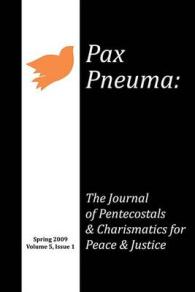- ホーム
- > 洋書
- > 英文書
- > Science / Mathematics
Full Description
Arsenic in drinking water derived from groundwater is arguably the biggest environmental chemical human health risk known at the present time, with well over 100,000,000 people around the world being exposed. Monitoring the hazard, assessing exposure and health risks and implementing effective remediation are therefore key tasks for organisations and individuals with responsibilities related to the supply of safe, clean drinking water.
Best Practice Guide on the Control of Arsenic in Drinking Water, covering aspects of hazard distribution, exposure, health impacts, biomonitoring and remediation, including social and economic issues, is therefore a very timely contribution to disseminating useful knowledge in this area. The volume contains 10 short reviews of key aspects of this issue, supplemented by a further 14 case studies, each of which focusses on a particular area or technological or other practice, and written by leading experts in the field. Detailed selective reference lists provide pointers to more detailed guidance on relevant practice.
The volume includes coverage of (i) arsenic hazard in groundwater and exposure routes to humans, including case studies in USA, SE Asia and UK; (ii) health impacts arising from exposure to arsenic in drinking water and biomonitoring approaches; (iii) developments in the nature of regulation of arsenic in drinking water; (iv) sampling and monitoring of arsenic, including novel methodologies; (v) approaches to remediation, particularly in the context of water safety planning, and including case studies from the USA, Italy, Poland and Bangladesh; and (vi) socio-economic aspects of remediation, including non-market valuation methods and local community engagement.
Contents
Arsenic in drinking water sources and consequent human exposure; Public health effects of arsenic exposure; Health surveillance and biomonitoring; Regulatory aspects of arsenic in drinking water; Sampling and analysis for monitoring arsenic in drinking water; Selection of arsenic remediation strategies in the context of water safety plans; Remediation Overview; Sustainable arsenic mitigation - from field trials to implementation for scaling up safe water access; Community awareness and engagement for arsenic management; Valuing the damage of arsenic consumption: economic non-market valuation methods; Arsenic hazard and associated health risks: New England, USA aquifers; Geostatistical modelling of arsenic hazard in groundwaters; Estimating the population exposed to arsenic from private water supplies in Cornwall; Hair arsenic as a reliable biomarker of exposure to arsenic in drinking water; Automated On-line Arsenic Monitoring; ARSOlux - Biosensor Water Quality Monitoring; Centralised Arsenic Removal from Drinking Water in the United States; Survey of real scale water treatment plants in Italy; Case studies on best practice in Italy; Remediation case study: drinking water treatment by AOCF to target < 1µg.L-1 effluent arsenic concentration; Control of arsenic in the European Union: Case studies from Poland; Arsenic removal from water by reverse osmosis technology; Case Study: The Social Context of Arsenic Regulation and Exposure in South East Hungary; Case Study: Arsenic Cambodia Groundwaters.








